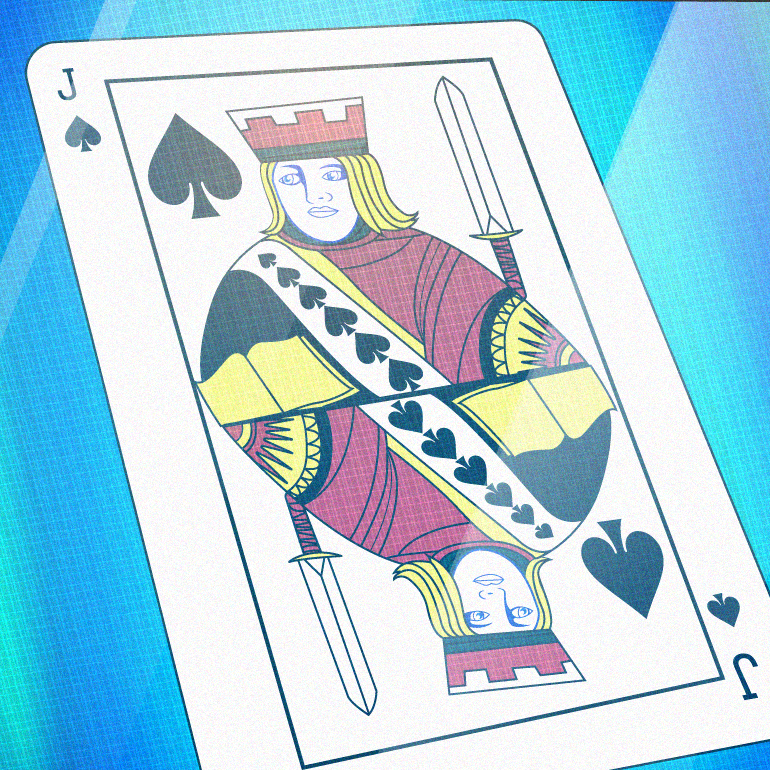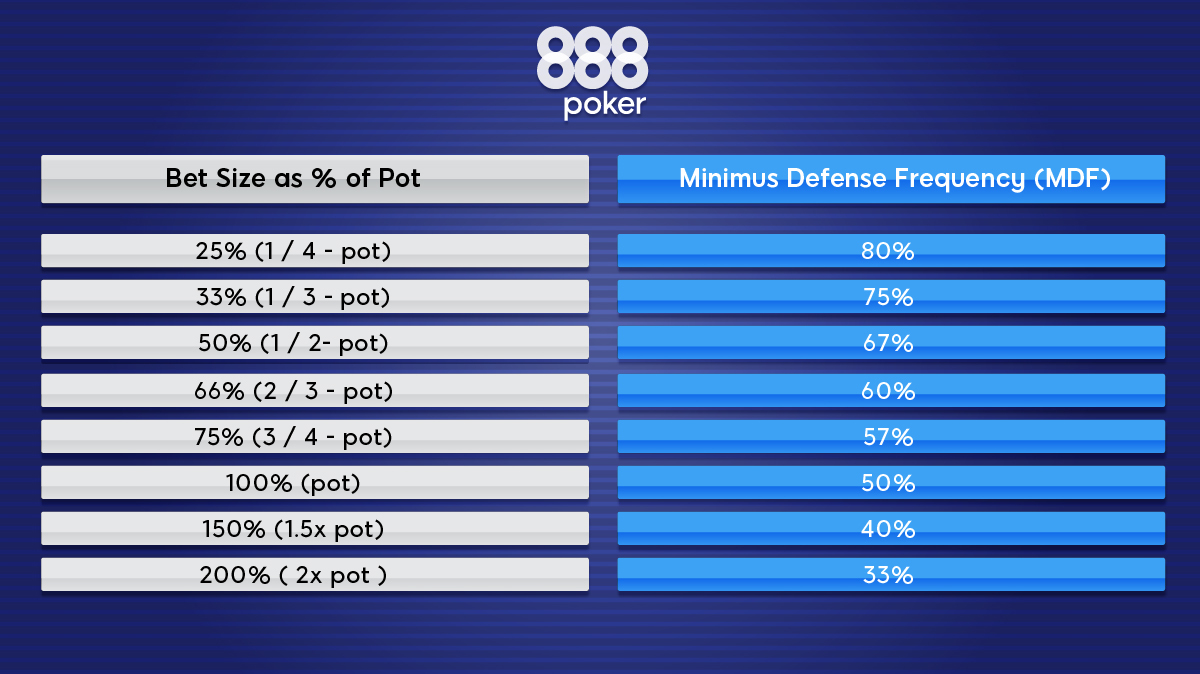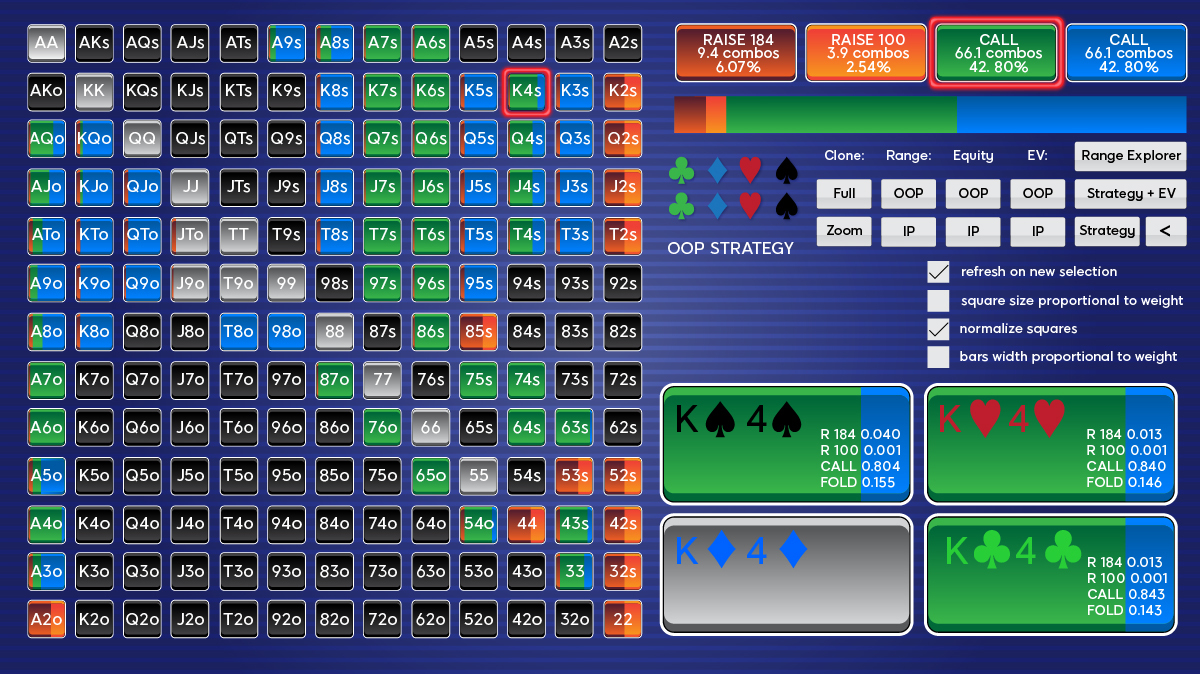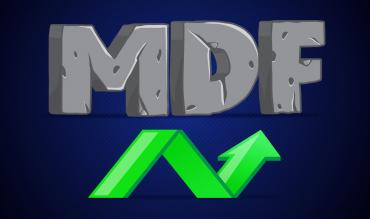Table of Contents
What Is MDF?
Minimum Defense Frequency (MDF) is a mathematical concept used in poker to determine the amount of your hand range that you should be defending and continuing with (either by calling or raising) when facing a bet from your opponent.
When to Use MDF?
Before delving into the likes of how to calculate it and apply it in practice, it’s essential to be reminded of the two broad strategies you can use to counter your opponents at the poker table:
-
Game Theory Optimal (GTO): This situation is where you play a fundamentally solid strategy that is unexploitable, choosing bet sizes and hand ranges that only allow your opponents to make mistakes while you play fundamentally sound poker.
- Exploitative: This scenario is where you notice the leaks (flaws) in your opponents’ strategies and look to deviate from GTO strategies to counter these errors in an effort to yield higher profits than GTO poker would against your specific opponent(s).
Note that most players do not play poker following GTO/fundamentally sound strategies, except at the highest stakes. They can often profit more from using an exploitative approach against players found in their games.
Also, note that the concept of MDF applies to the GTO poker strategy. Therefore, the primary situations where you should be looking to use MDF in practice would only be when you have no reads on your opponent(s) or the typical tendencies of your player pool yet.
How to Use MDF?

Minimum Defense Frequency will relate your opponents bet size and the size of the pot to the amount of your range that you should be calling with. The formula to calculate MDF is:
INITIAL POT SIZE / (INITIAL POT SIZE + BET SIZE)
Therefore, let’s imagine a possible river situation in a 200NL live game where the pot is $150, and your opponent goes all-in for his last $100.
In this scenario, we take the variables and plug them into the formula:
MDF = $150 / ($150 + $100)
MDF = $150 / $250
MDF = 0.6
MDF = 60%
What this means is that whatever your range looks like at the river, to be unexploited by your opponent’s bluffs, you must continue (call) with 60% of your range.
Basic MDF Chart
Here is a helpful chart we’ve created to help you easily determine what percentage of your range you must be defending according to MDF - relative to come common bet sizes (expressed as a percentage of the pot):

MDF Example in Practice
Let’s suppose you are playing in a $0.50/$1.00 online game.
Action folds to the Button (BTN) who raises to $2.50. SB folds.
Hero is in BB with K ♥4 ♥ and calls.
The flop comes 6♠ 4♦ 2♥. You check, the BTN bets $1.50 into $6.00. You call.
The turn comes the 2♣. You check. Your opponent bets $4.50 into $9.00. You call.
The river is the 7♥. You check, and your opponent bets $13.50 into $18.00.
Should you be calling this river?
This bet is 75% of the pot, which means that we must continue with about 57% of our river range to not be exploitable, according to the chart above.
Let’s take the numbers from this example and plug them into the formula once more:
MDF = INITIAL POT SIZE / (INITIAL POT SIZE + BET SIZE)
MDF = $18 / ($18 + $13.50)
MDF = $18 / $31.50
MDF = 0.57
MDF = 57%
Believe it or not, assuming that we’ve played optimally and defended appropriately up until this point in the hand, this makes K ♥4 ♥ actually a call here.
(To help us visualise our range and how we should be appropriately playing this river, we’ve input all of the information from this hand into a poker solver program called PioSolver):

All of the highlighted squares indicate various combinations that should still be a part of our range. The different colours show us what we should do with them.
As you can see (from green indicating the hands that we should call with), K ♥4 ♥ is very much within our calling range here.
NOTE: Remember, recommending a call here uses the concepts of GTO strategy surrounding MDF. If you know the tendencies of your opponent and/or regcognise that he or she doesn’t bluff flop/turn/rivers as often as is optimal here, then exploitatively, you might be able to find a fold with this hand.
When to Avoid Using MDF
There are a few specific instances where you shouldn’t use the concepts of MDF.
These situations are as follows:
- When playing against weak players (and/or those who don’t bluff): As mentioned previously, more money can be made from your opponents when you use exploitable strategies rather than those surrounding the concepts of GTO. If you know your opponent is bluffing more often than he should, then you should call down more frequently with a wider range of hands. (To add to this, you could use MDF as your baseline, and then expand out a calling range from there.)
Similarly, if you know your opponent only bets when they have strong holdings (and almost no bluffs or none at all), then the concept of MDF goes out the window. MDF is used to remain unexploitable against your opponents’ bluffs, rendering it useless if your opponent will always have something when he or she bets.
- When defending against flop continuation bets from out of position: Because you’re already going to have a difficult time realising your equity by calling an open out of the big blind, you shouldn’t be using MDF to defend against cbets from OOP. If you do, (simply because you’re out of position) some of the range that you’ll be defending will, in fact, be –EV.
Breaking Down MDF in Summary
Minimum Defense Frequency (MDF) relates the size of your opponents’ bets to the correct action you should be taking, in many instances (similar to the concept of “pot odds”).
MDF is a concept that you should be practising away at the table, especially after first being introduced to it. It will help you develop a knack for thinking about your entire range (a vital part of winning poker strategy. You will also start developing an idea for which hands you should continue within various situations - taking into account different board textures and varying bet sizes.
After taking the time to create this baseline MDF strategy, you will better know how to appropriately deviate from it when you’re looking to counteract your opponents’ play optimally.
Even if you don’t abide by it precisely in practice (because you want to play a more exploitative approach than a GTO one). Simply because versus your opponents, you can profit more this way.


